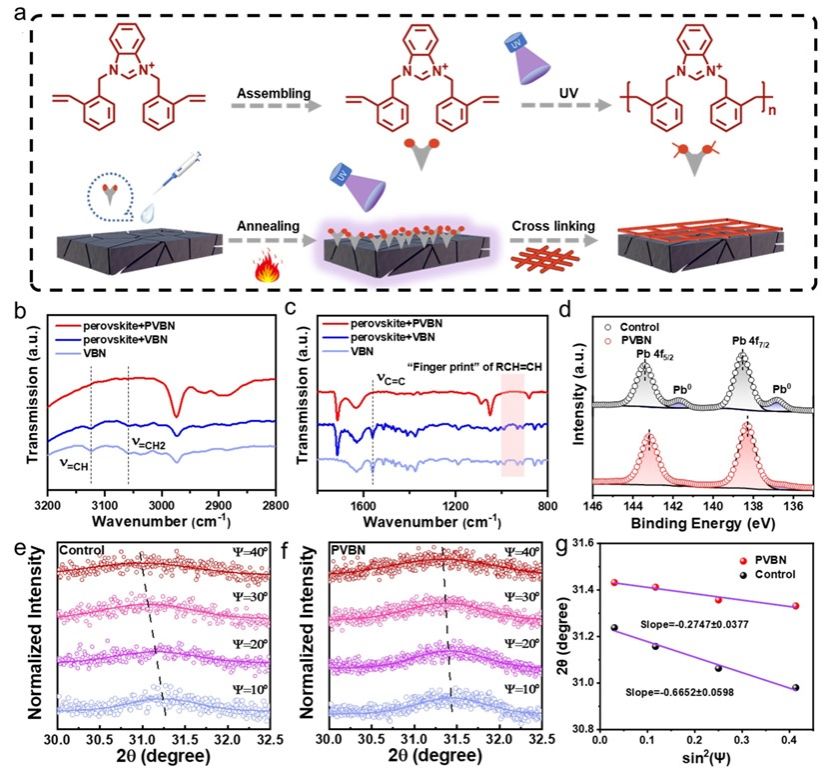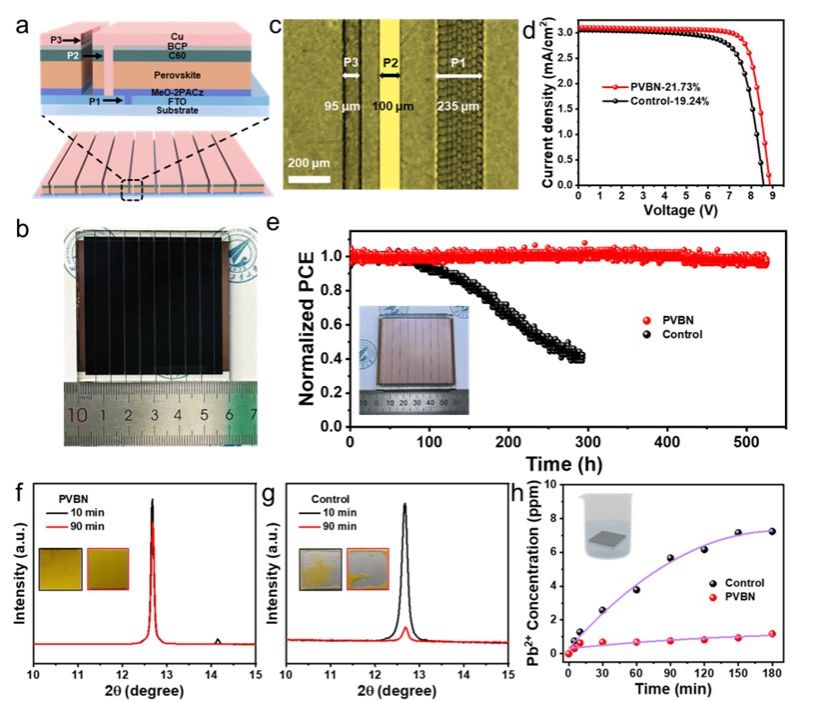
论文链接:https://doi.org/10.1016/j.nanoen.2024.110190
Research Background
Metal halide perovskite has shown remarkable advancements in small-area perovskite solar cells (PSCs), achieving power conversion efficiencies over 26%. This progress is primarily due to enhanced passivation strategies and interface engineering. While small molecule passivators improve stability, they can volatilize and decompose under light and heat, undermining their effectiveness. To address these issues, stable polymers have been employed to modify perovskite surfaces, reducing trap states and enhancing efficiency. In-situ crosslinked polymers also promise better interface contact, leading to higher stability and efficiency. However, challenges remain regarding conductivity and impurities in existing polymers. Therefore, designing ionic monomer-based crosslinking molecules with good conductivity and efficient passivation is crucial to reducing interfacial losses in PSCs.
Research Overview
Here we designed a cationic conductive-passivation molecule, 1,3-bis(2-vinylbenzyl)-1 H-benzimidazolium chloride (referred to as VBN), which includes a cross-linkable vinylbenzyl for in-situ crosslinked VBN (PVBN) and a benzimidazole functional group to effectively modulate the perovskite surface. According to experimental results, PVBN effectively fulfilled halide vacancies on the perovskite surface through saturating the Pb2+ sites, and released the surface residual strain of perovskite by crosslinking network, and enhanced interfacial charge extraction and transfer due to π-π stacking of conjugated benzene rings. Benefiting from the conductive-passivation crosslinking, the fabricated PSCs attained a distinguished PCE of 25.30 %, which is a record efficiency for the crosslinking-modulated inverted PSCs. The unencapsulated PSC presented impressive operational stability, maintaining 92.8 % of its initial PCE after continuous illumination for 1200 h. Furthermore, it exhibited a prolonged lifetime with 90 % and 95 % of the original values remaining after exposure to 85 °C for 1200 h and 2000 h shelf storage, respectively. In addition, the PVBN network effectively suppress lead leakage with a suppression rate of 83.6 %. The PVBN-modified 36-cm2-area modules were successfully fabricated, achieving a remarkable efficiency of 21.73 % with excellent operation stability, underscoring the substantial application potential of this conductive-passivation strategy in sustainable and extensive perovskite photovoltaics.
Research Highlights
1. Multifunctional benzimidazolium crosslinking on perovskite films to passivate defects and suppress lead leakage.
2. Crosslinked benzimidazolium network boosts interfacial charge extraction and reduces surface strain in perovskite films.
3. Interfacial crosslinking strategy enabled inverted modules to achieve 21.73% efficiency with excellent stability
图文导读

图1. (a)VBN分子经过退火处理作用于钙钛矿薄膜表面,随后在紫外灯照射下形成交联网络PVBN的过程示意图。(b,c)VBN粉末、经VBN/PVBN处理的钙钛矿粉末的红外光谱对比。(d)PVBN处理前后钙钛矿薄膜的Pb 4f峰的XPS光谱对比分析。(e,f)PVBN处理前后钙钛矿薄膜在不同倾斜角度下的GIXRD结果。(g)2θ-sin2(ψ) 的线性拟合。

图2. (a)反式钙钛矿太阳能电池器件结构示意图。(b)PVBN处理的器件截面SEM图像。(c)PVBN处理前后器件的冠军效率J-V曲线比较。(d)PVBN处理前后器件的600s稳态输出比较。(e)PVBN处理前后器件的30块独立电池PCE的统计分布。(f)近年来关于聚合物修饰反式钙钛矿太阳能电池的PCE总结。PVBN处理前后器件的(g)储存稳定性对比、(h)热稳定性对比、(i)工作稳定性对比。

图3. (a)PVBN处理前后纯电子型器件的SCLC测试。(b)PVBN处理前后器件的暗态J-V曲线。(c,d)PVBN处理前后钙钛矿薄膜表面的电势分布。(e)PCBM与PVBN/PCBM的电子迁移率测试。PVBN处理前后器件的(f)Voc-Light关系、(g)Mott-Schottky曲线、(h)瞬态光电压测试、(i)瞬态光电流测试。

图4. (a)36cm2反式钙钛矿模组结构示意图。(b)模组实物图。(c)激光划刻刻蚀线(P1-P3)图片。(d)PVBN修饰前后模组的J-V曲线。(e)PVBN处理前后封装组件的工作稳定性。(f,g)PVBN处理前后钙钛矿薄膜在水中浸泡10分钟和90分钟的XRD图谱。(h)PVBN处理前后钙钛矿薄膜在水中浸泡不同时间的铅泄露浓度记录。
Conclusion
In summary, we propose an ionic conductive-passivation strategy to enhance the efficiency and stability of inverted PSCs through crosslinked molecule modulation. We found the PVBN network effectively coordinated the unsaturated Pb2+ sites, reduced residual strain and accelerated interfacial charge extraction and transfer. Thus, highly efficient and highly stable perovskite photovoltaics were achieved. The champion optimal efficiency of inverted PSCs reached up to 25.30 %, as well as 21.73 % for minimodules. Moreover, these devices exhibited excellent long-term stabilities. Furthermore, the effective suppression of lead leakage by PVBN modification contributes to the development of environmentally-friendly PSCs. Our studies indicate that this conductive-passivation network as a modifier has potential applications in the perovskite photovoltaics and electronic devices.
Corresponding Author Profile
Chen Ruihao, Professor at the School of Materials Science and Engineering, Northwestern Polytechnical University. He has published over 40 papers in international journals such as the Journal of the American Chemical Society and Angewandte Chemie, and holds 15 national invention patents, 5 of which have been granted. He has led seven projects, including those funded by the National Natural Science Foundation, the Youth Foundation, and various provincial projects in Guangdong and Chongqing. His current research focuses on the interface regulation of high-performance perovskite solar cells and the development of large-scale components, as well as space perovskite-silicon tandem photovoltaic devices.
Wang Hongqiang is a Professor and Vice Dean of the School of Materials Science and Engineering at Northwestern Polytechnical University. He is a national-level leading talent and a Fellow of the Royal Society of Chemistry. As the first or corresponding author, he has published over 130 SCI papers in important international journals in the field of materials, including Chemical Society Reviews, Advanced Materials, Angewandte Chemie International Edition, Journal of the American Chemical Society, Science Advances, and Nature Communications, with an H-index of 51 (Web of Science). He holds 31 authorized invention patents in China and Japan. His research focuses on advanced energy and catalytic materials, with a systematic study on the innovative research of nanocrystal laser-implanted low-carbon energy devices.